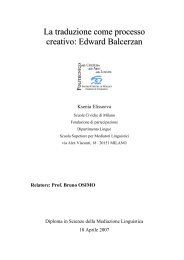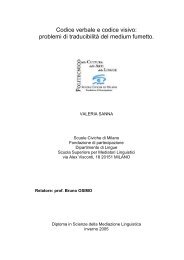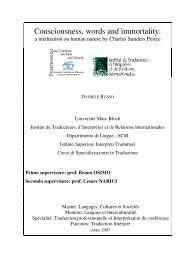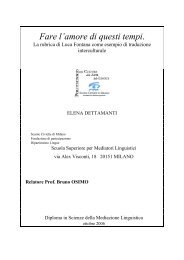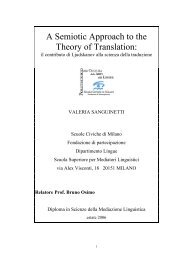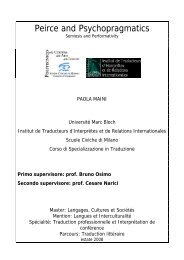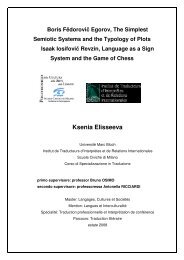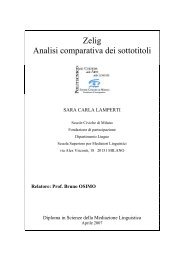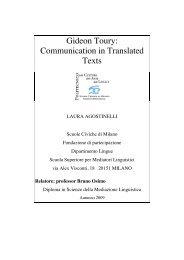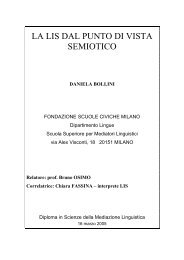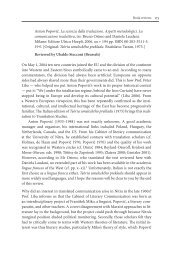Relatore: Professor Bruno OSIMO - Bruno Osimo, traduzioni ...
Relatore: Professor Bruno OSIMO - Bruno Osimo, traduzioni ...
Relatore: Professor Bruno OSIMO - Bruno Osimo, traduzioni ...
You also want an ePaper? Increase the reach of your titles
YUMPU automatically turns print PDFs into web optimized ePapers that Google loves.
“This means that people are able to slow down the normal process to<br />
synchronize it with verbalization” (Someren, Barnard and Sandberg 1994: 33).<br />
When the subject has completed the task, part of the information moves<br />
on to LTM, leaving behind retrieval cues in STM: in such cases, it has been<br />
found that post hoc verbalization is difficult and often incomplete (Ericsson<br />
and Simon, 1993). Moreover, under these circumstances, it can be extremely<br />
problematic to exclude the possibility that a subject is interpreting his own<br />
thought processes or even generating them anew, instead of retrieving them<br />
from LTM.<br />
Secondly, to make sure that the subject actually reports his mental states<br />
without distorting them, it is important that he does not feel he is taking part<br />
in a social interaction: although conversation is obviously a natural situation,<br />
it involves reworking thoughts to conform them to socially established norms;<br />
this process might sensibly alter the information attended to (Bernardini<br />
1999). Emotional and motivational factors can produce a cognitive process<br />
different from the process that would take place without thinking aloud.<br />
“There is not much evidence that thinking aloud adds much to the effect of<br />
being studied and evaluated that is inevitable in knowledge acquisition and<br />
experimental settings” (Someren, Barnard and Sandberg 1994: 33). The<br />
interaction between subject and experimenter (or between subjects) should<br />
therefore be avoided or at least reduced to a minimum. There is one other<br />
cause for concern: if the subject keeps silent for a long time, the verbalization<br />
will become useless, because significant parts of the cognitive process in STM<br />
may not be tracked down. To avoid this, the experimenter is allowed to repeat<br />
to the subject to think aloud with a short and non-intrusive reminder; Ericsson<br />
and Simon propose to use the phrase “keep talking” (Krahmer and Ummelen<br />
2004).<br />
Thirdly, “practice and experience may affect the amount of processing<br />
carried out in STM, so that fewer mental states will be available for<br />
verbalization to subjects experienced in a task” (Bernardini 1999: 2). This<br />
process, known as ‘automation’ refers to the fact that “as particular processes<br />
15



